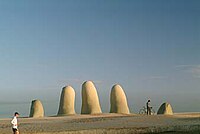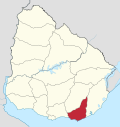Punta del Este: Difference between revisions
→Twin towns – Sister cities: clean up and general fixes using AWB |
No edit summary |
||
| Line 34: | Line 34: | ||
|website = |
|website = |
||
}} |
}} |
||
'''Punta del Este''' is a city and resort on the Atlantic Coast in the [[Maldonado Department]] of southeastern [[Uruguay]]. Although the city has a year-round population of about 9,280,<ref name="pop" /> the summer tourist boom adds to this a very |
'''Punta del Este''' is a city and resort on the Atlantic Coast in the [[Maldonado Department]] of southeastern [[Uruguay]]. Although the city has a year-round population of about 9,280,<ref name="pop" /> the summer tourist boom adds to this a very large number of non-residents. |
||
'''Punta del Este''' is also the name of the municipality to which the city belongs. It includes the following two zones: Punta del Este and Península. |
'''Punta del Este''' is also the name of the municipality to which the city belongs. It includes the following two zones: Punta del Este and Península. |
||
Revision as of 16:30, 30 July 2013
Punta del Este | |
|---|---|
City | |
 Port of Punta del Este | |
| Country | |
| Department | Maldonado Department |
| Founded | 1907 |
| Government | |
| • Mayor (Alcalde) | Martín Laventure (NP) |
| Area | |
| • Total | 20.35 km2 (7.86 sq mi) |
| Population (2011) | |
| • Total | 9,277 |
| Demonym(s) | puntaesteño (m) puntaesteña (f) |
| Time zone | UTC −3 |
| postal code | 20100 |
| Dial plan | +598 42 (+6 digits) |
Punta del Este is a city and resort on the Atlantic Coast in the Maldonado Department of southeastern Uruguay. Although the city has a year-round population of about 9,280,[1] the summer tourist boom adds to this a very large number of non-residents.
Punta del Este is also the name of the municipality to which the city belongs. It includes the following two zones: Punta del Este and Península.
Location
The city is located on the intersection of Route 10 with Route 39, directly southeast of the department capital Maldonado and about 140 kilometres (87 mi) east of Montevideo.
History
The first Europeans to set foot in what is now Punta del Este were the Spanish at the beginning of the 16th century. However, the colonization of the area actually began around Maldonado at the end of the 18th century due to Portuguese expansionism. [citation needed] Punta del Este and its surroundings (Maldonado and Punta Ballena for example) at the end of the 19th century were kilometers of sand and dunes, but in 1896 Antonio Lussich bought 4,447 acres (1,800 ha) of uninhabited land and there he started a botanic garden, Arboretum Lussich, and planted trees and plants from all over the world. Later the trees started to spread on their own, and now the area is full mostly of Pines, Eucalyptus, Acacias and various species of bushes.
On 5 July 1907, it was declared a "Pueblo" (village) by the Act of Ley 3.186.[2] Its status was elevated to "Ciudad" (city) on 2 July 1957 by the Act of Ley Nº 12.397.[3]
Punta del Este hosted an American Summit in 1967 attended by U.S. President Lyndon Johnson. In September 1986, Punta del Este played host to the start of the Uruguay Round of international trade negotiations. These negotiations ultimately led to the creation of the World Trade Organization in 1994.
Population
In 2011 Punta del Este had a population of 9,277[1] and 23,954 households and apartments.[4] According to the Intendencia Departamnetal de Maldonado, the municipality of Punta del Este has an area of 48 km2 (19 sq mi) and a population of 15,000.[5]
| Year | Population |
|---|---|
| 1963 | 5,272 |
| 1975 | 7,197 |
| 1985 | 6,731 |
| 1996 | 8,294 |
| 2004 | 7,298 |
| 2011 | 9,277 |
Source: Instituto Nacional de Estadística de Uruguay[2]

Climate
Punta del Este has a mild oceanic climate (Cfb, according to the Köppen climate classification), with pleasant summers and cool winters. The precipitation is evenly distributed throughout the year, with an average of 1,010 mm (40 in). The hottest month, January, has an average temperature of 21.7 °C (71.1 °F), and the coldest month, July, has an average of 11.5 °C (52.7 °F). The average yearly temperature is 16.6 °C (61.9 °F).
| Climate data for Punta del Este | |||||||||||||
|---|---|---|---|---|---|---|---|---|---|---|---|---|---|
| Month | Jan | Feb | Mar | Apr | May | Jun | Jul | Aug | Sep | Oct | Nov | Dec | Year |
| Mean daily maximum °C (°F) | 25.2 (77.4) |
25.1 (77.2) |
24.0 (75.2) |
21.2 (70.2) |
18.2 (64.8) |
14.8 (58.6) |
14.4 (57.9) |
14.7 (58.5) |
16.0 (60.8) |
18.4 (65.1) |
21.0 (69.8) |
23.8 (74.8) |
19.7 (67.5) |
| Mean daily minimum °C (°F) | 18.1 (64.6) |
18.4 (65.1) |
17.6 (63.7) |
14.9 (58.8) |
12.1 (53.8) |
9.5 (49.1) |
8.7 (47.7) |
8.8 (47.8) |
9.9 (49.8) |
11.4 (52.5) |
14.1 (57.4) |
16.4 (61.5) |
13.3 (56.0) |
| Average precipitation mm (inches) | 75.4 (2.97) |
84.8 (3.34) |
79.3 (3.12) |
84.0 (3.31) |
91.4 (3.60) |
80.3 (3.16) |
90.3 (3.56) |
93.9 (3.70) |
93.1 (3.67) |
85.0 (3.35) |
86.8 (3.42) |
66.6 (2.62) |
1,010.9 (39.82) |
| Average precipitation days | 8 | 9 | 9 | 9 | 9 | 10 | 10 | 9 | 9 | 9 | 8 | 8 | 107 |
| Source: World Meteorological Organization[6] | |||||||||||||

The coastline

Punta del Este has scenic coasts and beaches. There are two types of coastlines: Brava and Mansa. This shows the end of the Río de la Plata (River Plate) on one side and the beginning of the Atlantic Ocean, on the other side. Every beach of the peninsula has public access. There are quiet and calm water beaches while others have strong waves, white and fine sand or thick and golden ones. The split between wave types is around the Monumento al Ahogado, which the sculptor designed to warn swimmers that the rough waves could cause them to drown.
La Barra is popular for nautical sports and fishing during the day. At later hours, La Barra becomes a central attraction for the younger generation. Starting from the end of December through to the second week of January, this location becomes a place for the local people as well as tourist to gather in the night life festivities.Other areas include the resort of El Tesoro, Montoya beach, Bikini beach and Manantiales beach. These beaches are a favourite spot for the younger generations as well as for many famous argentinian or Uruguayan TV personalities and models. These are also some of the best surfing beaches in the coastline.
Main sites

The city has much colonial architecture contrasting with more modern buildings. Nowadays it has a scenic shore, typical resort houses, modern buildings, a port with mooring capacity, department stores, restaurants, and pubs. There are several large houses, and gardens lined with plants.
Gorlero Avenue, the main avenue of Punta del Este has commercial galleries, restaurants, cinemas, casinos, shops.
Artigas square, over Gorlero Ave is the place where there is a popular handicraft market.[7]
Casapueblo
This icon of Punta del Este is an artwork by the Uruguayan painter and sculptor Carlos Páez Vilaró. It sits atop Punta Ballena, as one of the main attractions of the peninsula. The artist began working on the project in 1958, and took 36 years to be completed.
It is universally considered as a “living sculpture”. Inside this masterpiece there are many rooms facing the sea. It also boasts sculptures, paintings and ceramics made by its creator. During the summer season there are sunset classical music concerts. It is possible to view the sunrise over the Atlantic Ocean and the sunset over the Río de la Plata in Punta Ballena.
Punta del Este Lighthouse
The lighthouse is 45 metres tall, and the crystal panels which are part of its illumination system were brought from France. It works by electricity, with acetylene gas as emergency backup. It is possible to climb the 150 steps of its spiral staircase.[8]


Gorriti Island
This island of 21 hectares of surface is daily visited to enjoy its two beaches: Garden Port and Honda beach. It consists of a natural port, with ships anchoring close to it, and it also became a popular area to practice water sports.
Transportation
The city is served by Capitán de Corbeta Carlos A. Curbelo International Airport, being the second most important of Uruguay, located near Laguna del Sauce on the outskirts of the city. This modern airport opened in 1996. It offers domestic and international flights within the region.
Punta del Este can be reached from Buenos Aires by ferryboat to Montevideo (the capital city), 140 km from Punta del Este, and then by car or bus.
Most international flights land at Carrasco International Airport around 115 km from Punta del Este. The bus companies Copsa and Cot connect the airport with Punta del Este, and are there are several private taxi and remise services available.[9]
Places of worship
Punta del Este has numerous temples:
- Parish Church of Our Lady of Candelaria (Roman Catholic)
- Fatima Chapel (Roman Catholic)
- St. Raphael Chapel (Roman Catholic)
- Rafael Temple[10][11] (Jewish)
- Beit Yaacov[10][11] (Jewish)
- Beit Jabad[10][11] (Jewish-Chabad)
Twin towns – Sister cities
Punta del Este is twinned with:
 Marbella, Spain
Marbella, Spain San Francisco, USA
San Francisco, USA
See also
References
- ^ a b "Censos 2011 Cuadros Maldonado". INE. 2012. Retrieved 25 August 2012.
- ^ a b "Statistics of urban localities (1963–2004)" (PDF). INE. 2012. Retrieved 8 September 2012.
- ^ "LEY N° 12.397". República Oriental del Uruguay, Poder Legislativo. 1957. Retrieved 10 July 2011.
- ^ "Censos 2011 Maldonado". INE. 2012. Retrieved 25 August 2012.
- ^ "Presupuesto-2011-2015". Intendencia Departamnetal de Maldonado. 2012. Retrieved 11 September 2012.
- ^ "World Weather Information Service". World Meteorological Organization.
- ^ "Punta del Este Highlights. Tours at Punta del Este".
- ^ Secretaría de Comunicaciones y Prensa. "Ciudad de Punta del Este : Faro de Punta del Este" (in Spanish). IMM. Retrieved September 10, 2010.
- ^ "Airport/Transport". Aeropuerto Internacional de Carrasco. Retrieved 14 January 2013.
- ^ a b c Synagogues in Punta del Este
- ^ a b c "The Jewish tourist capital in South America". Aurora Israel. Retrieved 31 March 2013. Template:Es
External links
- Official site of Punta del Este municipality
- Correo Uruguayo – Stamp for the 100 years of Punta del Este, with notes on its history.
- Article on the Port of Punta del Este, Official Portal of the Uruguayan Government
- INE map of Punta del Este and San Rafael–El Placer
- Map of the municipality of Punta del Este
- Punta del Este at Curlie
 Punta del Este travel guide from Wikivoyage
Punta del Este travel guide from Wikivoyage

